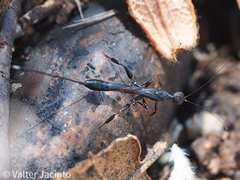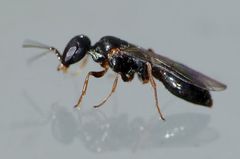Messor barbarus

Messor barbarus, commonly known as the Iberian harvester ant or locally as the hormiga granívora, is a species of ant from the family Formicidae, prevalent throughout the Comunidad Valenciana. This species is particularly noteworthy for its granivorous diet and complex social behavior.
Characteristics:
- Size: Workers range in size from 5 to 12 mm, and queens can reach sizes up to 16 mm, making them distinguishable by their robust appearance.
- Color: They are primarily black or dark brown, with some exhibiting reddish mandibles or legs.
- Habitat: Messor barbarus is commonly found in open fields, grasslands, and along the Mediterranean coast, preferring dry and warm environments typical of the Valencian landscape.
- Nests: Their nests are usually underground and can be identified by distinctive entrance mounds made of soil and plant debris.
Behavior and Diet:
- Colony Structure: The colonies can contain thousands of ants, with a clear division of labor among workers, soldiers, and the queen.
- Feeding Habits: Messor barbarus is a granivorous species, primarily feeding on seeds. This diet influences their role in the ecosystem as seed dispersers.
- Life Cycle: Like many ants, they undergo complete metamorphosis, with egg, larva, pupa, and adult stages. The nuptial flights occur in late summer, during which new queens and males mate.
Ecological Importance:
Messor barbarus plays a critical role in the ecological balance of the region by aiding in soil aeration and seed dispersal. Their foraging activities help to maintain the health of the ecosystems in which they dwell.
Understanding the behavior and significance of Messor barbarus not only contributes to our appreciation of the local biodiversity in the Comunidad Valenciana but also emphasizes the importance of preserving such species and their habitats.







